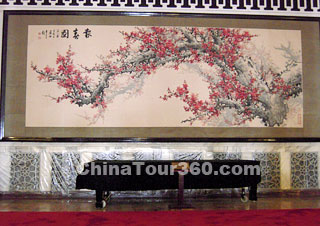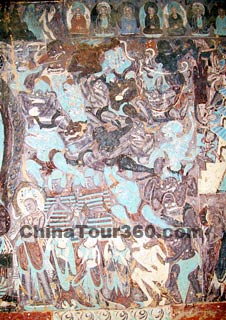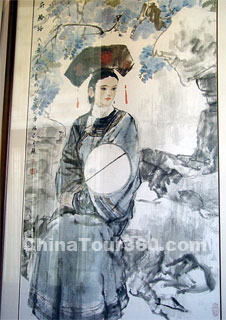The roots of Chinese painting can be traced back to Neolithic pottery. It was closely related to crafts like pottery as observed in the decorations used on decorative bronzes, carved jade and lacquer ware such as figures of fish, frogs, deer, birds, flowers, tree leaves and dancing people which dates back to around 6,000 to 7,000 years. Paintings were mainly painted on silk or walls before the Tang Dynasty (618 - 907), and murals were particularly popular. It is also believed that the hieroglyph is the origin of Chinese painting.
|
|
Classical Chinese painting can be divided into three categories: landscapes, figures and birds-and-flowers. Images of emperors, philosophers, and court ladies provide role models from the past; landscapes and bird-and-flower paintings demonstrate the central place of nature in Chinese thought. Religious paintings reflect both the Taoist philosophy native to China and Buddhism.
The range of themes depicted in figure painting was extended far beyond religious ideas during the Song Dynasty (960 - 1127). The Tang Dynasty was considered the golden age for figure painting. Historical subjects and scenes of courtly life were popular, and the human figure was portrayed with a robustness and monumentality unequalled. The kind of historical character and stories of everyday life became extremely popular. Also, techniques were further refined. The most famous work is the Nymph of the Luo River painted by Gu Kaizhi of the Eastern Jin Dynasty (317 - 420).
 |
| A Chinese Brush Painting |
Landscape painting had already established an independent form of expression by the 4th century. It gradually developed into the two separate styles mainly 'blue-and-green' and 'ink-and-wash' landscapes. The blue-and-green landscape used bright blue, green and red pigments derived from minerals to create a richly decorative style. The ink-and-wash landscape relied on vivid brushwork with varying degrees of intensity of ink to express the artist's conception of nature, his own emotions and individuality.
Flower-and-bird painting was separated from decorative art to form an independent genre around the 9th century. Many well-known artists painted in this genre during the Song Dynasty and their themes included a rich variety of flowers, fruits, insects and fish. Many of the scholarly painters working with ink and brush used a great economy of line. They produced paintings illustrating things such as plum blossoms, orchids, bamboo, chrysanthemums, pines and cypresses which reflect their own ideals and character. Each artist has distinct themes. During the Tang Dynasty, Cao Ba and Chen Hong were good at drawing horses, Feng Shaozheng was special in drawing eagle, and Xue Ji was good at drawing cranes.









